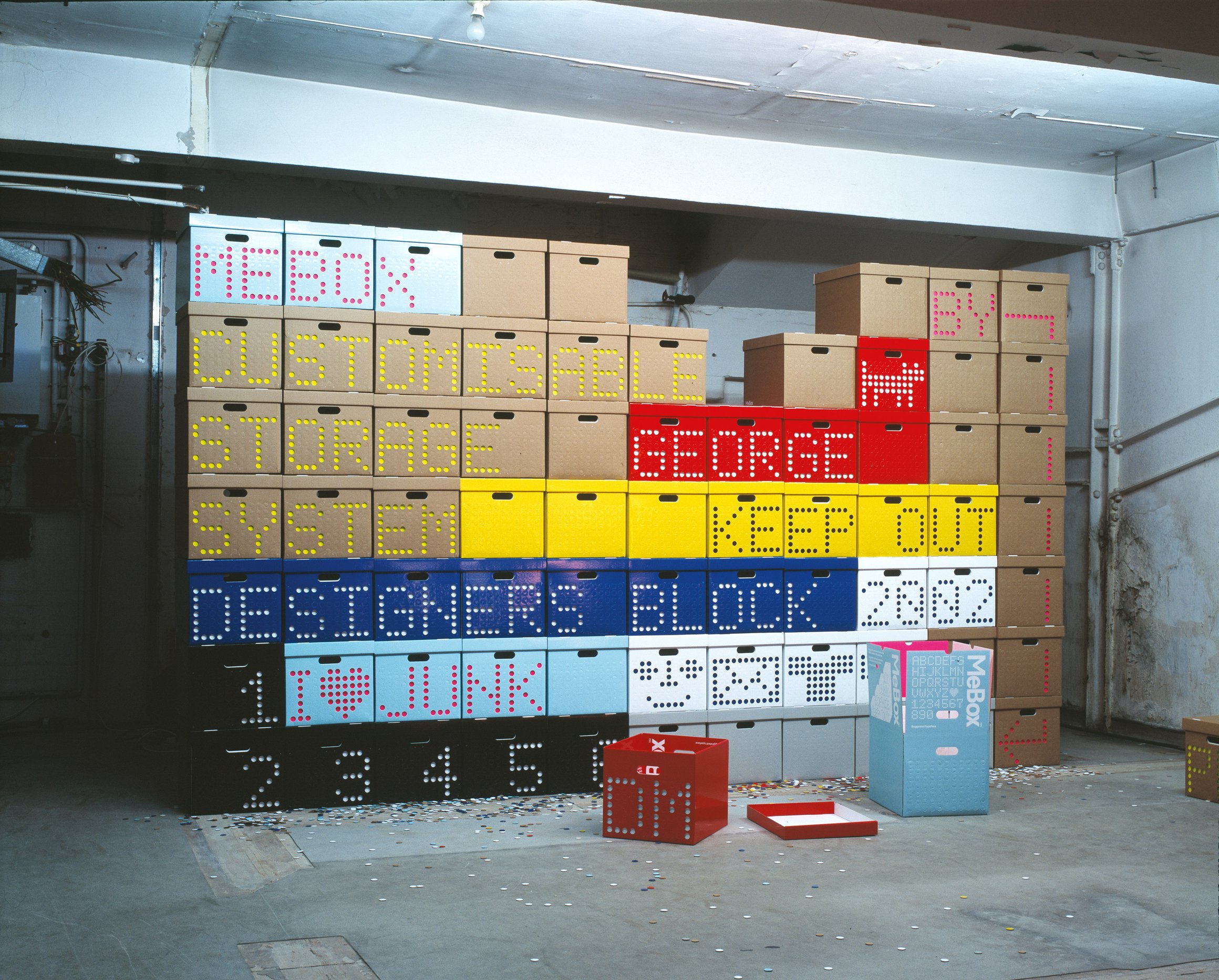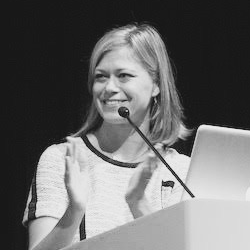
MeBox storage system designed by Graphic Thought Facility (GTF) in 2003
The work of Graphic Thought Facility, a London-based graphic design consultancy, is on show at the Art Institute of Chicago until August 17. It’s the first time the Art Institute has staged a show solely on contemporary design and it’s also the first time it has devoted an exhibition to a single design firm. It’s interesting that for this double debut the museum rejected potential blockbuster fodder and instead chose the equivalent of an indie movie: a British graphic design firm, whose brilliant, but distinctly unostentatious work, is relatively unknown in the US design community, let alone among the general public.
For me the decision makes perfect sense: not only do I think GTF is one of the finest design firms currently practicing, and that the more people who are exposed to their work the better, I also believe it’s the duty of museums with design departments to take such risks and to function as test sites for new ideas, not just venues for prudent blockbusters. As the museum prepares to open its new Renzo Piano-designed Modern Wing in Spring 2009, thereby significantly increasing the space available to examinations of architecture and design, this show helps to highlight some of the issues associated with the display of contemporary design.
How best to present design in a museum has preoccupied curators ever since the South Kensington Museum opened to the public in 1857 as the repository for decorative art and “modern manufactures” objects left over from the Great Exhibition. Funding sources and intransigent museological traditions determine whether designed objects in permanent collections are displayed as works of art, as consumable commodities, or as instructional models for student designers: At MoMA’s 76-year old architecture and design department, art-display conventions prevail; London’s late 20th-century Design Museum takes its visual cues from the industrial showroom; while the V&A’s didactic installations signal its nineteenth-century origin as a design school. And, of course, the demarcation between gallery space and design store continues to erode.
“Graphic Thought Facility: Resourceful Design” features several case studies for the firm’s pragmatic and often lo-fi approach to the design of identities, books, packaging and promotions. Most of their clients are quintessentially British firms like the furnishings store Habitat, Shakespeare’s Globe Theater, the Design Museum, and Frieze, London’s major annual contemporary art fair. Founding partners Paul Neale and Andrew Stevens met as students at the Royal College of Art at the end of the 1980’s, when the design community was in thrall to the Macintosh computer. Eschewing the slick surfaces and techno-focused explorations of most graphic production of the 1990’s, GTF developed an approach in which found materials and the handmade are prioritized and the constituent parts of the graphic design process are exposed and celebrated. Their catalogue for “Stealing Beauty,” a 1999 exhibition about design’s practical and philosophic engagement with the everyday, epitomizes GTF’s use of considered bricolage: copy-shop spiral binding holds together an array of ephemera associated with the exhibition—even a champagne label which is there in lieu of the sponsor’s logo—the bits of paper punched out for the binding are scattered across the cover like confetti.
Having already designed the framing graphics for numerous other graphic design exhibitions, GTF are acutely aware of the challenges that come with exhibiting graphic design. When you extricate graphic design from the urban commercial context for which it was intended and reinsert it in the rarefied atmosphere of a museum it loses what GTF refer to as its “tension of use.” A museum cannot accommodate graphic design’s multiplicity, or its ephemerality. Since only one example of each item is shown frozen in time, we are often presented with a poster trapped in continual promotion of an event that continues to recede into the past or a logo still trumpeting the core values of a now defunct corporation. Stripped of its functional qualities —its immediacy and expendability—graphic design in the museum tends to look awkward, like a market-stall crier taking tea in a hushed parlor.
Graphic design has been displayed in museums as art, as cultural or historic artifact and as consumable commodity, but rarely in a way that reflects its full complexity as a functioning entity embedded within systems of use. Here, using the display mechanism of the institutional bulletin board, GTF have presented their work as information.
Back in 1999, although they were invited to participate in “Stealing Beauty” as featured designers, GTF proposed instead to design the graphics for the exhibition, which took place at London’s Institute of Contemporary Art. This was partly to do with their desire to control the way they are presented and partly due to their reluctance to be in a position where they might be considered as artists. Here again, they’ve turned the invitation to exhibit into a design brief. Their solution is specific both to the site and to the nature of graphic design itself. Bulletin boards are of course explicitly concerned with conveying information, and their positioning in the corridor-like exhibition space, which leads to administration offices, feels entirely appropriate.
In art museums, works are expected to speak for themselves. In design museums, explanations need to go beyond the obvious, especially when dealing with graphic design, a field of practice that, though familiar, for most of the viewing public remains mysterious and somewhat mute. To fully appreciate GTF’s promotional campaign for the Frieze Art Fair which takes place each year in London’s Regent’s Park, it’s useful (and delightful) to know how and why decisions were made: the stenciled letter logotype, for example, was inspired by the stamped labels on shipping containers used to transport the art to the fair. Additionally, rather than focusing on the art itself, each year the campaign’s photographic images highlight a different aspect of the park—its ducks and squirrels and soccer-playing or picnicking visitors. In 2006 GTF commissioned an aerial photography company to capture high-resolution aerial images of the park using a radio-controlled helicopter, fitted with a radio-controlled camera on an anti-vibration mount. The resulting images expose a usually inaccessible and other worldly view of aspects of park life. Particularly beautiful is the shot of empty boats on the pond. The low-level aerial viewpoint turns them into flattened abstract shapes and reveals the secret concord of their colored interiors, a pleasure usually reserved only for the birds.
GTF’s brightly colored bulletin boards contain detailed labels on each project, the parts of which are pinned in place like butterflies using long metal pins specially sourced by the designers. But how else might these trophies be vivified? For those of us at the opening of the show last month, there was a Q&A with the designers Neale and Huw Morgan (GTF’s third partner) at which curator Zoe Ryan elicited commentary and anecdotes that helped explain the various projects included. For others, there is a very nice portable catalogue, the fourth in a series of similar catalogues the Art Institute has published in conjunction with Yale University Press. I didn’t actually see anyone using it in conjunction with the exhibit on that opening night, but its guidebook format suggests that it could be.
Ultimately, this is not a groundbreaking exhibition. But in looking graphic design practice so squarely in the face, through the work of designers who do the same, we gain a clear portrait of one firm’s techniques and approaches, the way in which graphic design is valued and supported by London’s cultural and commercial institutions, as well as a practicable proposal for how it might continue to be meaningfully presented in a museum context at this exciting new venue in the United States.


Comments [12]
06.08.08
07:58
06.08.08
10:37
If you're willing to never touch them, they are very pretty though.
06.09.08
11:53
06.09.08
03:46
risks and to function as test sites for new ideas, not just venues for
prudent blockbusters.
Museums with design departments don't seem to be tempted by
"prudent blockbusters" on the subject of graphic design too often.
The last one in the US was at the Walker Art Center about twenty
years ago.
I would love to see a graphic design blockbuster, prudent or
otherwise, at a US museum sometime in my lifetime, but I'm not
holding my breath.
06.09.08
10:32
06.10.08
08:55
about this exhibit. Thanks foe the great write up I now know what I
am doing this weekend other than the old town art fair! I am totally
pissed I missed GTF speak though...
06.11.08
09:33
Of course large institutions want to appeal to the greatest number of people when putting on exhibitions, but though our profession rarely receives the nod to exhibit on such a scale, it should not be lost on the community to exhibit itself.
If for anything small or large exhibitions should be put on to deviously raise the awareness of select solutions as integral pieces of art and subsequently put that thought in the viewers minds that what we do maybe worth a little more. haha.
Though I do believe the Niklaus Troxler's posters did do a tour or at the very least exhibited at the MIA in Minneapolis. That should be in consideration as recognition, though he is "artier" than some.
Per MB's last recollection of a large GD exhibition, I'd like to throw a nudge nudge at Andrew Blauvelt and Olga Viso to consider such an idea already being the experienced and most apt to do it anyways.
06.11.08
01:29
"prudent blockbusters" on the subject of graphic design too often.
The last one in the US was at the Walker Art Center about twenty
years ago.
I would love to see a graphic design blockbuster, prudent or
otherwise, at a US museum sometime in my lifetime, but I'm not
holding my breath.Text
I don't know if you'd exactly call it a blockbuster, but Bruce Mau's Massive Change exhibition, which ran at Chicago's Museum of Contemporary Art [which doesn't have a design department] in 2006, was a truly inspirational show about many aspects of design, not just graphics. That said, AIC's GTF show certainly isn't a blockbuster but is still extremely well done and worth seeing.
06.16.08
01:00
We are a company based in Hong Kong and have been providing custom made suits & shirts since 1997. With representatives in major cities around the globe we can arrange to show you the fabric samples and take your measurements, or you can also place your orders online with the help of our measuring guide. There are over 2000 fabrics to choose from along with all the latest styles.
All our suits and shirts are produced by highly skilled Shanghainese tailors in Hong Kong and delivered in about 4 weeks, express delivery can be made in 2 weeks at a minor extra cost. In case you are not able to find what you are looking for then please let us know your requirement may it be in words or by a photograph and we could arrange it for you.
We also have an outlet at the Hotel Intercontinental Budapest where you are most welcome to visit us. Though we are not located in streets like Savile Row (London), we have still been able to offer made to measure suits to many VIP’s from around the world.
Experience an easier way of shopping for bespoke suits & shirts at Euro Tailors
Kenny Surtani
06.18.08
09:57
12.21.09
01:02
01.21.10
08:41